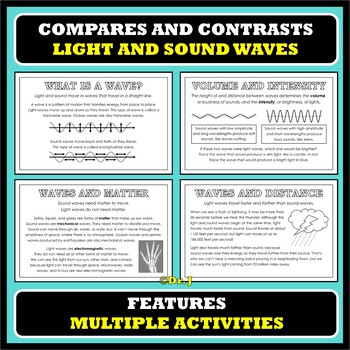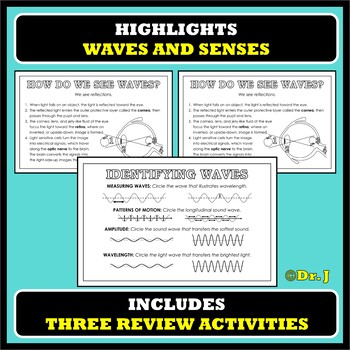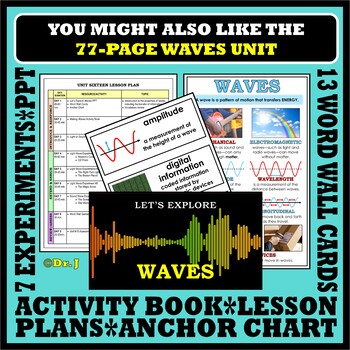MAKING WAVES: Comparing Light and Sound Waves (Science Foundations series)
- PDF
Also included in
- Meeting your science standards is a breeze with the SCIENCE FOUNDATIONS ACTIVITY BOOK BUNDLE, a comprehensive set of more than 20 interactive science books that covers the major themes of elementary science—from biomes and food chains to physics and weather—all at a bundle savings of 20%. Each bookPrice $48.00Original Price $60.30Save $12.30
Description
Introduce your students to the similarities and differences between light and sound waves with MAKING WAVES: Comparing Light and Sound Waves, from the Science Foundations curriculum. Making Waves uses multiple activities to explore the differences between light and sound, including the ways they are sensed. This engaging book also includes three review activities, with answer keys.
TOPICS INCLUDED:
- Forms of Energy
- What Is a Wave? (Patterns of Motion)
- Measuring Waves (Amplitude and Wavelength)
- Volume and Intensity
- Light and Color
- Waves and Matter (Electromagnetic vs. Mechanical Waves)
- Waves and Distance
- How Do We Hear Waves?
- How Do We See Waves?
- Fun Facts About Light and Sound
- Identifying Waves Review
- Light or Sound? Review
- Wave Power Crossword Review
Science Vocabulary Words and Phrases:
amplitude, electromagnetic wave, energy, intensity, light energy, light wave, longitudinal wave, matter, mechanical wave, sound energy, sound wave, transverse wave, volume, wavelength
Targeted Skills:
- Identifying properties of light and sound waves
- Developing critical thinking skills of comparing and contrasting
- Building content-area literacy in science
- Reading fluency and comprehension
Sample Pages: Please see the preview to view actual pages from the book.
Image Credits: The illustrations in this book are my own original drawings (©Dr.J).
Technical Info: The book is in PDF format.
RELATED RESOURCES:
- LET'S EXPLORE WAVES POWERPOINT
_________________________________________________________________
CHECK OUT THE ENTIRE UNIT
This activity book is included in UNIT 16: EXPLORING WAVES of the Foundations Science Curriculum. The complete unit also contains a 24-slide animated PowerPoint with 7 video/sound clips, 13 word wall cards (in two sizes), 6 science experiments, 11 x 17 inch Waves anchor chart, review activities and assessments, a Teacher’s Guide with lesson plans, and the BONUS RESOURCE, Light or Sound? cut-and-glue Venn diagram. NOTE: Each unit in the series is self-contained and can be used as a stand-alone resource.
_________________________________________________________________
BUNDLE AND SAVE : This book is included in two bundles...
- Save 20% with the EXPLORING SCIENCE ACTIVITY BOOK BUNDLE, which contains all 22 books in the series.
- SAVE 25% with the FOUNDATIONS SCIENCE CURRICULUM BUNDLE, which contains all 20 units in the year-long curriculum. Each unit includes a Teacher’s Guide with lesson plans, animated PowerPoints with video clips, activity books, experiments and projects, Word Wall vocabulary cards, anchor charts, bonus resources, reviews and assessment, and more! The bundle also includes detailed Scope and Sequence charts for the curriculum as a whole and for each individual unit. Click on the BONUS PREVIEW to view the Scope and Sequence charts.
_________________________________________________________________
ACTIVITY BOOKS IN THE SCIENCE FOUNDATIONS SERIES:
INTERDISCIPLINARY SCIENCES
- INTRODUCING SCIENCE (The Three Branches and the Scientific Method)
- FAMOUS SCIENTISTS (Discoveries that Changed the World)
- EXPLORING CYCLES (Life, Planetary, and Biogeochemical Cycles)
LIFE SCIENCES
- THE ANIMAL KINGDOM (Groups and Inherited Traits)
- FREE-THE PLANT KINGDOM (Traits, Life Cycles, and Photosynthesis)
- BIOMES AND ECOSYSTEMS (Interactions Among Living Organisms and Environments)
- ANIMAL ADAPTATIONS (Survival in a Changing World)
- FOOD CHAINS AND WEBS (Connections Among Living Organisms)
EARTH SCIENCES
- GEOLOGY ROCKS! (Layers of the Earth and the Rock Cycle)
- FORECASTING THE WEATHER (Our Changing Atmosphere)
- WATER SOURCES AND CYCLES
- THE FOUR SPHERES (Atmosphere, Biosphere, Geosphere, Hydrosphere)
- FOSSIL FUELS (Formation, Uses, and Conservation)
- REDUCE, REUSE, RECYLE (Conserving Our Natural Resources)
- EARTH AND SPACE (Planetary Force and Motion)
- FIRSTS IN SPACE (Milestones in Space Exploration)
PHYSICAL SCIENCES
- STATES OF MATTER (Characteristics and Changes)
- FORMS OF ENERGY (Exploring Kinetic and Potential Energy)
- MAKING WAVES (Comparing Light and Sound Waves)
- FORCE AND MOTION (Exploring Physics with Sports)
- OUR MAGNETIC EARTH (Properties and Uses of Magnets)
- ELECTRICITY (Exploring Electrical Energy)
_________________________________________________________________
ABOUT THE CURRICULUM
This unit is part of the Science Foundations Curriculum, a set of 20 units designed to give students a solid understanding of the basic science concepts outlined in the Next Generation Science Standards (NGSS) and the Texas Essential Knowledge and Skills (TEKS) standards. The year-long curriculum has the following features:
- Comprehensive Coverage: The curriculum contains 20 units that highlight key concepts in the earth, life, and physical sciences. Each unit is based on a 9-day lesson plan, which can easily be lengthened or shortened to meet the needs of your students.
- Sequential Arrangement: The units are arranged sequentially, with each unit building on knowledge gained in the previous units.
- Differentiated Instruction: The curriculum covers the standards for Grades 3-5, which makes it perfect for differentiated teaching and learning in a multi-level classroom. It can also be used as a stand-alone curriculum or as an enriching supplement to your required curriculum.
- Engaging Resources: Each unit contains a wide variety of high-interest resources, including an introductory PowerPoint, activity books, experiments and projects, word wall vocabulary cards, anchor charts, review activities, and assessments.
CLICK HERE to view all of the activity books, PowerPoints, units, and other resources currently available in the Science Foundations series.
_________________________________________________________________
Connect with Let’s Get Real
Visit My Store: Click here to view more than 500 resources for building content-area and multicultural literacy. Look for the category list on the left side of the home page to find a specific science or social studies topic. Be sure to click on the GREEN STAR to receive updates on new resources.
Pinterest: Click here to check out the Let’s Get Real Pinterest boards for more ways to enrich your teaching themes.
_________________________________________________________________
Customer FAQs
What kinds of resources does Let’s Get Real offer?
All of my K-5 books, printables, posters, and games focus on content-area literacy—building the specialized vocabulary of science and social studies—because having an extensive vocabulary is not only a top predictor of reading success, it also has a huge impact on overall school success and standardized testing scores. My science materials target topics and standards outlined in the NGSS and TEKS. In social studies, I concentrate on multicultural literacy, providing resources that develop a knowledge of and appreciation for the diverse cultures in our global society.
How can I see what you offer or know when you’ve added new materials?
Click on the star to the right of this description (under my pic) OR click on my store link (above), then click on the star at the top of the page to follow Let’s Get Real. You’ll be the first to know about new materials, sales, and freebies. To view the resources by science/social studies topics, look to the left on the store page, under the heading Custom Categories.
What are TPT credits and how do I get them?
Every time you provide feedback for a purchase, TPT gives you 1 credit for each dollar you’ve spent. After you’ve used (and hopefully loved!) a resource, hover on your picture at the top of the page and open the “My Account” tab. Click on your “My Purchases” category. You should see a list of your purchases with a “Provide Feedback” button for each one. Just click the button and you’ll be taken to a page where you can rate the product and leave a comment for me. You can apply the credits you earn to any future purchases and I always appreciate your positive feedback.
What do I do if I have a question about or problem with a resource?
You can always contact me through the product Q & A tab, located at the bottom of the product description.
_________________________________________________________________
Terms of Use
Please “share the love” by telling others how much you like Let’s Get Real products; but please don’t share the copyright. Each Let’s Get Real resource—including graphics and illustrations—is copyrighted by Dr. J/Teaching Texas LLC and may not be redistributed, sold, or placed on the internet. This resource is for one teacher-use only. Thank you for your support!






